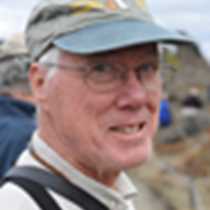Brown Bluff, Antarctic Sound, Antarctica
Surely, there are readers of this document who think that watching the ocean freeze is a term to describe abject Antarctic boredom, the marine equivalent of watching paint dry. We beg to differ.
In the early morning hours, the National Geographic Explorer was heading northeast along the coast of the Antarctic Peninsula. The temperature was well below freezing, and the ocean surface was developing a sheen of grease ice, the first stage of ocean freezing. Seawater freezes at about 28.7 degrees F. (the precise temperature depending on its salinity.) Colder air above the ocean was causing the surface to freeze. The grease ice separated into discrete, rounded packets of dinner plate to serving platter size, to form pancake ice. Our Zodiacs pushed through this ice to bring us to the shore at Brown Bluff, wearing pretty much all of the warm clothing that we had brought. We were greeted by a parade of Adélie penguins marching along the shore. We gave them the right of way and settled down to watch the spectacle. The penguins formed into lines and marched along the shore, sometimes hurrying, sometimes not. Occasionally a gentoo penguin crossed the parade route, or joined in for a while. One lone chinstrap penguin wandered through, stopping to pose for pictures with his Adélie and gentoo relatives. Groups of penguins massed on the rocks at the water's edge, and the groups grew in numbers as more penguins joined in. The birds became increasingly restless until a swell of penguin murmuring rose to a crescendo. Birds in the back of the group pressed forward, while those in the front seemed to resist the trend. Sometimes the movement was aborted and the murmuring stopped; at other times, it culminated in a mad, simultaneous rush into the sea and the penguins headed out to feed, porpoising through and over the freezing (literally) water.
Adélie penguins nest in large colonies of many thousands of pairs. Leopard seals wait in the water near the colony to snatch a passing penguin. They are ambush predators, lurking behind floating pieces of glacial ice (bergy bits) or rock reefs to grab penguins as they come and go. Today, the ice continued to grow until it formed a gelid slush that obscured what might be beneath the surface. Conditions were perfect for lurking; good for leopard seals, not so good for penguins. The birds found it difficult to swim through the frozen surface, making them easy prey. We were watching penguins caught in a behavioral conflict; they must leave the colony to feed and then return to take their turn at incubation of the two eggs, but to do so they carry the risk of becoming the seal's next meal rather than a successful penguin parent. By leaving in a coordinated rush, each penguin reduces the chance that he or she will fall victim. Over and over, throughout the breeding season the evolutionary game of penguin and seal, prey and predator, is played out. Today, the freezing ocean tipped the balance in favor of the predator, and we watched a leopard seal dispatch its prey. I doubt that predation by leopard seals is a significant limiting factor for penguin reproductive success or cause of the decline in Adélie penguins that is occurring over the Antarctic Peninsula region. More likely, it is food availability, as influenced by the amount and distribution of winter sea ice.
And so we departed Antarctica. In Antarctic Sound, off the tip of the Peninsula, we passed through a field of massive, flat-topped, straight-sided tabular icebergs calved from the disintegrating ice shelves of Antarctica. Following dinner we passed through scenic
English Strait, a passage through the South Shetland Islands, to enter the Drake Passage and begin our trip up to Ushuaia.




